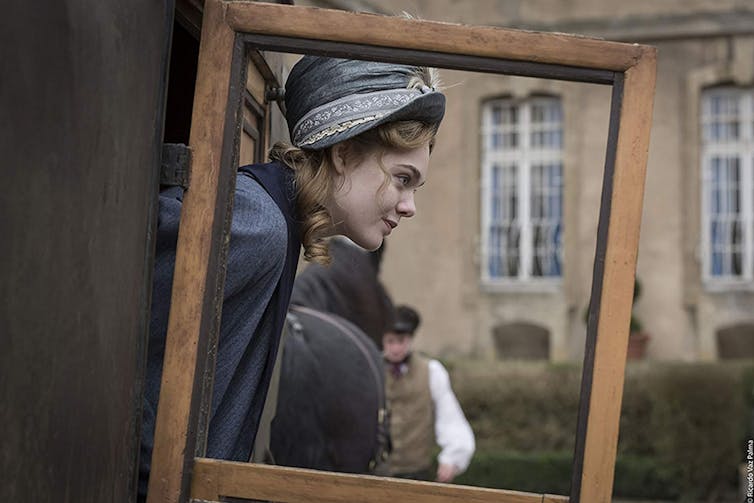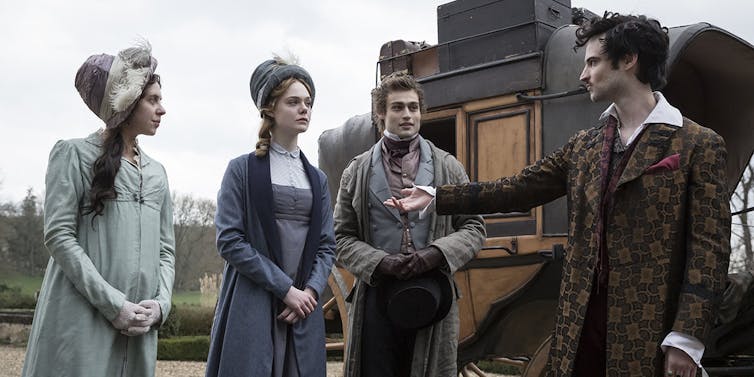
Frankenstein was conceived by the 18-year old Mary Shelley while she was with her stepsister Claire Clairmont, the poets Lord Byron and Percy Bysshe Shelley, and Byron’s physician John Polidori. The setting was grey, wet Geneva, in the so-called “year without a summer”, 1816, when the volcanic ash of a huge volcanic eruption in Indonesia blotted out the sun, wreaking havoc across the globe’s climate system. Crops failed, livestock died, famine was widespread, and the apocalypse appeared nigh — a perfect setting for a ghost story competition.
Unable to go boating or walking, and cooped up inside Byron’s chalet by the lake, Polidori drafted The Vampyre. But Mary Shelley (played by Elle Fanning in the film) won the competition with Frankenstein, her “hideous progeny” as she called it — the moving tale of the mad scientist Frankenstein and his abandoned, unnamed creature. While the poetry of Shelley and Byron is not much read today, Frankenstein is one of the world’s most popular and admired books.
Mary Shelley is the latest release by director Haifaa al-Mansour, Saudi Arabia’s first female filmmaker, best-known for her critically acclaimed Wadjda (2012). Al-Mansour directed Wadjda via walkie talkie from the back of a van in Riyadh because Saudi women are forbidden to mix publicly with men. Unsurprisingly, the film focuses on her country’s gender oppression: 10-year old Wadjda longs to own a bicycle so that she can race against her friend Abdullah but bikes are not for girls.
Mary Shelley transposes these themes of gender oppression to the business of writing and literary celebrity in the early-19th century. The film opens to the sounds of furious scribbling and incantatory snatches of lurid gothic prose, composed and jotted down by Mary, the 16-year old daughter of two revolutionaries, the political philosopher William Godwin and the feminist Mary Wollstonecraft.
With her mother dying soon after childbirth, the young Mary Wollstonecraft Godwin is growing up in a straitened, loveless household run by a shrewish stepmother (Joanne Froggatt). An avid reader, especially of ghost stories, Mary longs to be a writer herself, the challenge being to find her own voice.
To assist her in this quest, the radical, young (but married) poet Percy Shelley (Douglas Booth) arrives on the scene, drawn like a magnet to the child of two giants in his pantheon of free thinkers. After a brief courtship centred on Wollstonecraft’s grave and inspired by high-sounding poetry and the revolutionary ideals of sexual equality, free love and communal living, Mary elopes with Percy, taking Claire, her complicated and troublesome stepsister, along with her.
In its focus on abandonment and loneliness, and the ways in which free love and sexual liberation can go badly wrong for women, and even worse for their children, the film is fired by today’s #MeToo movement. Many of the painful, actual details of the writers’ lives are condensed, but the high cost of male libertinism is a message powerfully delivered by Al-Mansour. Percy’s abandoned first wife Harriet drowns herself, the narcissist Percy accuses Mary of hypocrisy when she refuses a sexual liaison with his friend Hogg, and Lord Byron (Tom Sturridge) monsters the pregnant Claire (Bel Powley) by describing their affair as a “lapse in judgement”.
 Claire Clairmont (Bel Powley), Mary Shelley, Percy Shelley (Douglas Booth), and Lord Byron (Tom Sturridge) (IMDB)
Claire Clairmont (Bel Powley), Mary Shelley, Percy Shelley (Douglas Booth), and Lord Byron (Tom Sturridge) (IMDB)
One of the film’s most original moves is to bring the controversial Claire Clairmont centre stage, where she always wanted to be. Bolder than her stepsister, Claire tired of having to share Percy with Mary so she targeted her own poet, one richer and more famous than her stepsister’s. Graphic evidence of Claire’s pursuit of Byron, the rock star of his generation, has survived in her extraordinary letters to him, the first of which warns him that “the Creator ought not to destroy his Creature” in refusing her proposed tryst. She got her way and while Byron later acknowledged Claire’s child as his own, he suspected the “brat” was Percy’s.
Entangled sexually, Elle Fanning captures Mary Shelley’s quietly fierce but loyal nature. Although her idea of Heaven was “a world without a Claire”, she is always protective and compassionate towards her rival, an historical detail well conveyed by the film. Later in life, long after Shelley and Byron were dead, the now childless and still grieving Claire bitterly denounced both poets for their “free love” philosophy, a creed which made them “monsters of lying, meanness, cruelty and treachery”.
Frankenstein is a book which lives in its present moment. In 1824, it was mobilised in the British Parliament to oppose the abolition of slavery. The fear was that the suddenly freed slave would resemble Frankenstein’s creature, a man in physical strength and sexual passion, but an infant intellectually.
In our own times sympathy for the creature as victim often jostles with fear. Ahmed Saadawi’s Frankenstein in Baghdad (2017), a novel set amid the violence of contemporary Iraq, features “Whatshisname”, a grotesque figure assembled from the body parts of suicide bombers and their victims. At first he seeks revenge for the dead that he embodies but he then turns to killing the innocent.
Last year also saw the publication by MIT of an edition of Frankenstein for scientists, carrying extensive footnotes concerning the creator’s duty of care towards his creation, be that a robot or an atom bomb.
Unfortunately, despite its powerful and innovative focus on the two injured women at the heart of this story, the film ends with a disappointingly conventional message. While Mary has found her authorial voice, she trails off into sentimentality when she reassures Percy (with a kiss) that, despite all the suffering entailed by his romantic idealism, she regrets nothing.
About Today's Contributor:
Deirdre Coleman, Robert Wallace Chair of English in the School of Culture and Communication, University of Melbourne

















